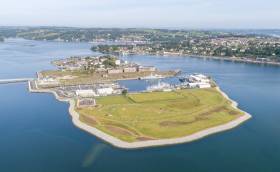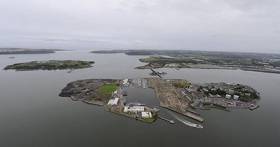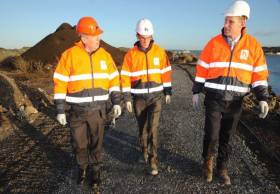Displaying items by tag: Haulbowline Island
Amazing Transformation as Cork Harbour's Remediated Haulbowline Island Celebrates First Birthday
One year on since completion, the Haulbowline Island Recreational Amenity in the heart of Cork Harbour is the largest project of its kind to date in Ireland.
The Haulbowline Remediation by Cork County Council has transformed the former East Tip site into a 22-acre People’s Park in the middle of the Harbour.
And, as we celebrate the first anniversary of the park, Afloat's 'before' aerial photos below show what an amazing transformation has been carried out by Cork County Council.

 650,000 cubic metres of by-products from steel production were deposited here over a 40-year period Photos: Bob Bateman
650,000 cubic metres of by-products from steel production were deposited here over a 40-year period Photos: Bob Bateman
Haulbowline, home to the headquarters of the Irish Naval Service, was also formerly the location of Ireland’s only steelworks from 1939 until its closure in 2001. 650,000 cubic metres of by-products from the steel production was deposited here over a 40-year period.
The extensive remediation of the site saw the delivery onto the island of over 15,000 HGV loads of material, 47,000 tonnes of rock armour material to protect the shoreline, 180,000 tonnes of subsoil and 37,000 tonnes of topsoil, transforming the site into the scenic landscaped recreational amenity it is today.
As Afloat previously reported, complete with 4kms of fully accessible pathways, a 1 km jogging circuit, playing pitches and seating areas that lend themselves to remarkable views of the harbour and wildlife observation, the island has hundreds of native tree mixes and plants to promote biodiversity.
From Slagheap to People’s Park: Taoiseach Opens New Cork Harbour Recreational Area After €25m Works
A former Cork Harbour slagheap turned park has been officially opened by the Taoiseach, as The Irish Times reports.
Taoiseach Micheál Martin was joined by local TD and Defence Minister Simon Coveney among others on Saturday (17 July) at the ribbon-cutting for what’s been named the People’s Park Haulbowline.
As previously reported on Afloat.ie, the park — on the site of the former Irish Steel slag heap at the east tip of Haulbowline island — includes 4km of harbour-side walkways, a 1km jogging circuit and numerous seating areas.
It has also been extensively landscaped with wildflower areas and more than 200 trees, rich with biodiversity and wildlife.
And its official opening marks the culmination of a multi-year, €25m remediation project that the Taoiseach says should stand as a model for the rest of the country.
“This is great day not for Corkonians but also for the people of Ireland,” he said. “It’s a national people’s park but it also reflects the genuine transformation that we can bring about at various sites.”
The Irish Times has more on the story HERE.
Bob Bateman's People's Park & Haulbowline Photo Gallery
Haulbowline Amenity Park Opens to the Public This Friday
Haulbowline Island Amenity Park in Ringaskiddy will be open to the public from tomorrow, Friday 15 January, Co Cork’s mayor has confirmed.
The park includes 4km of harbour-side walkways, a 1km jogging circuit and numerous seating areas to stop and take in the views of Cork Harbour.
It has also been extensively landscaped with wildflower areas and more than 200 trees, and is rich with biodiversity and wildlife.
Mayor of the County of Cork, Cllr Mary Linehan Foley welcomed the opening of the park and noted the value of safe areas for outdoor recreation, which are especially welcome at these times.
“Covid-19 restrictions have seen a huge uptake in people using our parks, beaches and greenways to get exercise within their 5km,” she said.
“Haulbowline Island Amenity Park will be a fantastic asset, particularly to the people of Ringaskiddy and the immediate surrounding area.
“People living outside 5km from the park will have to wait to visit Haulbowline but it will be worth the wait for the spectacular views of Cork Harbour.”
Cork County Council chief executive Tim Lucey noted the level of transformation that has taken place in the development of the park.
“The most innovative and customised solutions have been applied throughout with spectacular end results: excellent amenities and the establishment of woodlands and wildflower areas,” he said.
A spokesperson for Ringaskiddy and District Residents Association welcomed the opening of the park and highlighted the value of this amenity to local residents noting that “any environmentally-friendly recreational amenities are most welcome and long overdue for our community”.
Haulbowline Island Amenity Parkis gated and will be open to the public daily from 9am to 4.30pm in the winter months, with spring and summer hours to be decided.
Transformation of Haulbowline Island, Cork Harbour Voted Best National Engineering Project
The East Tip Haulbowline Island Remediation Project in Cork Harbour, was voted the National Engineering Project of the Year for 2019 at a ceremony held in Dublin.
As Afloat previously reported, Engineers Ireland invited members of the public to cast their vote in the shortlist of projects nominated in the awards' flagship category.
According to Engineers Ireland, the project in Cork Harbour was conducted by Cork County Council, RPS, PJ Hegarty & Sons and the Department of Agriculture, Food and the Marine.
The local authority engineering project that transformed the East Tip on the island (opposite Cobh) took the the lead at the 2019 Engineers Ireland Excellence Awards held in association with the ESB.
The remediation project, delivered on time and under budget, has seen 22 acres of the island’s East Tip transformed from a desolate, toxic, industrial site into a magnificent public recreational facility for local residents, workers and visitors in what has been one of the biggest environmental works in the history of the state.
The site at Haulbowline Island in Co Cork, formerly the home of Irish Steel, has been used for waste disposal for decades, with an estimated 650,000 cubic metres of slag and other waste metal from the steelworks deposited on the site from the 1960s until steel making ended at the plant in 2001.
Adopting the most innovative and customised engineering solutions throughout to overcome many challenges, the East Tip now boasts new playing pitches, walkways, cycleways, seating areas and the planting of hundreds of trees, woodlands and wildflower areas.
The Engineering Project of the Year category is sponsored by Transport Infrastructure Ireland and is voted for by a panel of judges and the public.
To read much more on the project click here (scroll down) to sub-heading: 'Immensely Challenging'
#corkharbour - Set to open on Haulbowline Island in Cork Harbour, is a public park despite warnings in a 2017 report that chemical contamination at the island’s former steel site has the potential to cause risks to users of a future park.
Now home to the Irish Naval Service, the GreenNews.ie reports that Haulbowline formerly housed the Irish Steel plant in the centre of the island from the late 1930s until its closure in 2001.
Over a 40-year period, 650,000 cubic metres of by-products and waste from the steelworks were deposited on a nine-hectare shallow sand spit on the island known as the East Tip.
Cork County Council was appointed as an agent for the Minister for Agriculture to oversee the regularisation of the site.
The East Tip has now been regenerated and is slated to open as a public park shortly, featuring playing pitches, walkways, cycleways, and over 200 trees and wildflower areas.
Much more on this story can be read here.
Visit by Prince Charles to Include Former British Navy Base During Three-Day Trip to the Republic
#NavyNews - A tour by the Prince of Wales of an Irish Naval Service patrol ship, to retrace steps of his ancestors in Cork and Kerry and be briefed on world-renowned conservation projects around Killarney are planned during his visit to the Republic next month.
It has emerged writes The Belfast Telegraph that the three-day visit was organised at the specific request of the Prince, who has for years wanted to visit a number of historic Cork and Kerry sites.
He will be accompanied by his wife, Camilla the Duchess of Cornwall for the visit, which is scheduled to begin in Cork on June 14.
The Belfast Telegraph has learned that Charles, who visited the Republic with Camilla in 2016, has specifically requested a tour of the historic Haulbowline Naval Base in Cork harbour.
It was formerly a strategically important dockyard of Britain's Royal Navy.
First fortified in 1602, not long after the Spanish Armada's failed invasion bid, Haulbowline Island is now the main base of the Irish Naval Service.
For more on the visit to the naval base located in lower Cork Habour click here.
Fire Crews Put Out Blaze At Haulbowline Navy Warehouse
#CorkHarbour - Independent.ie reports that firefighters have extinguished a blaze that broke out last night (Thursday 21 December) at the Naval Service base on Haulbowline Island.
The incident began around 9pm in a disused warehouse next to the officers’ mess and a number of other key buildings.
The fire quickly spread to the roof, where it could be seen across Cork Harbour.
Flames billowing out of the Naval Base in Cork Harbour @ralphriegel pic.twitter.com/645EQkXylx
— Darragh McGann (@McGannDarragh) December 21, 2017
All Naval Service personnel on base at the time were evacuated as a precaution and there were no casualties reported.
A fire last night in a disused building in our Naval Base, Haulbowline is now extinguished. An investigation will take place to establish cause. Thanks to our emergency service colleagues in #firebrigade, @GardaTraffic and our duty personnel for swift action to control the fire.
— Irish Defence Forces (@defenceforces) December 22, 2017
Marine Minister Michael Creed was on the other side of Haulbowline earlier this week to inspect remediation works on the East Tip waste site, as previously reported on Afloat.ie.
Marine Minister Inspects Haulbowline Remediation Works
#CorkHarbour - Marine Minister Michael Creed visited the East Tip at Haulbowline yesterday (Wednesday 20 December) to inspect progress on remediation works on the Cork Harbour island.
The minister’s visit follows the signing in July of the contract to commence an extensive remediation of the large East Tip waste deposit site as the main focus of the Haulbowline Island remediation project.
“I am very pleased to see the works now underway on the remediation of the East Tip site on Haulbowline,” said Minister Creed from the site. “Over the next 15 months the island will undergo a period of intense activity as the waste materials which have blighted the East Tip site are addressed.”
Cork County Council is acting as agent of the minister in the remediation project. The contract was awarded by Cork County Council to a consortium led by PJ Hegarty & Sons Ltd.
Cllr Sinead Sheppard said: “East Cork communities are relieved to see remedial works begin in the East tip site of Haulbowline and are grateful to Cork County Council for all the work carried out on the site making it safe and stable for the people living in the area.”
Cork County Council chief executive Tim Lucey added: “We have already reached a number of key milestones in this project including preparatory work which cleared the way for the completion of the project in the East Tip.”
Works being carried out on-site include marine elements to prevent tidal incursions to the site, access and infrastructure works and capping the waste materials to render the site safe, stable and suitable for future uses. Remediation is expected to be completed by the end of 2018.
#CorkHarbour - Marine Minister Michael Creed today (Monday 10 July) welcomed the signing of contracts to commence remediation of the East Tip as the main focus of the Haulbowline Island remediation project.
Commenting at the signing, Minister Creed said: “I am delighted that the tender process for this crucial step has been successfully concluded and that we can now look forward to the core remediation work at Haulbowline Island being addressed.
“The Government is committed to remediating Haulbowline Island and the East Tip is one of the most important aspects to be addressed.”
Cork County Council is acting as agent of the minister in the remediation of Haulbowline Island. The contract is being awarded by Cork County Council to a consortium led by PJ Hegarty & Sons Ltd and is for an extensive remediation of the East Tip waste deposit site.
The works on the Cork Harbour island — which also houses the headquarters of the Naval Service — will include marine elements to prevent tidal incursions to the site, access and infrastructure works and capping the waste materials to render the site safe, stable and suitable for future uses.
“We can expect remediation works will intensify from now until late 2018,” added Minister Creed. “There will be significant construction activity on the island, it will bring substantial benefits to the local economy and transform the island into a genuine national infrastructural asset.”
“The boy stood on the burning deck,” is one of the most famous lines in literature and particularly relevant in the maritime sphere. Many people can quote the next line…”Whence all but he had fled…” But why was he there, on what ship and in what circumstances? On this week’s edition of THIS ISLAND NATION we tell you the full story. While listening to it, I compared it with a following story on the programme, the threat to the operations of the Irish Naval Service by a commercial company.
It seems ludicrous that a fully operational Naval Service is under threat, but so it is and the warning has come from the Department of Defence, so it is the opinion of Government.
“This cannot be an acceptable situation….for the necessary functioning of a fully operational Naval Base…..” Those words, from the Department of Defence, are blunt and were made in a major intervention at a public inquiry held by Bord Pleanala into the Indaver Ireland waste company’s third attempt to build a hazardous waste incinerator at Ringaskiddy in Cork Harbour, close to Naval Base headquarters. The Department went further, stating that the location of the incinerator would also affect Air Corps operations, which “may be forced to impose a ‘no-fly’ restriction” around Haulbowline Island. “In addition, Haulbowline Island is accessed by road as a sort of cul de sac to the Ringaskiddy Road. The proposed incinerator is to be built adjacent to this road, before Haulbowline. Therefore, in the event of any accident at the incinerator, road access to and from Haulbowline is threatened. For example, if an accident at the incinerator necessitated local area evacuation, the evacuation of Haulbowline would be denied.
“This cannot be an acceptable situation for those that work at or visit Haulbowline, nor for the necessary functioning of a fully operational Naval Base therein.”
That makes the threat to the Naval Service very clear. No nation can accept a restriction imposed on its Naval Service operations. That must be national policy. I am proud of our Naval Service. It is a professional, top-level maritime organisation. Its rescue work in Irish waters has been superb. Its performance on refugee rescue in the Mediterranean has raised the profile of Ireland as a maritime nation. I do not accept that its operations should be threatened. I live in the Cork Harbour area. Through my kitchen window I see three wind turbines and several chemical factories. So harbour industrial development is an accepted part of my daily life, but a threat to our Naval Service is not acceptable.
Also under threat, publicly stated by the Minister for the Marine, is €500m. of marine development investment in the harbour if the incinerator, which he has described as “wrong place, wrong time,” is built. Concern has been voiced about youth sailing close to the incinerator and, if Air Corps helicopter operations are affected, what about the effect on Coast Guard helicopter operations in the area?
This is the 50th edition of THIS ISLAND NATION so a somewhat unusual coincidence of two Naval stories on the programme - that of the legendary boy who stood on the burning deck of the flagship of Napoleon’s fleet at the Battle of the Nile, the three-decked, 120-gun L’Orient and the threat to Ireland’s Naval Service
• Listen to the programme below:




































































